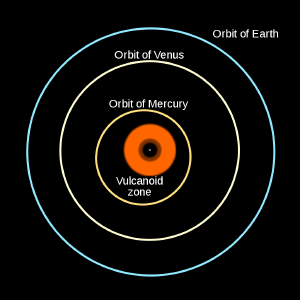Post
The Planet
That Never Was
17 July 2013
Mercury is the closest planet to the Sun, but that wasn’t always the case. To be more precise, there was a time when it was thought our solar system had a planet even closer to the Sun, known as Vulcan.
While there were speculations about a planet closer than Mercury going back to at least the 1600s, it wasn’t until the 1850s that Urbain Le Verrier discovered the first indirect evidence for such a planet. Le Verrier carefully calculated the orbit of Mercury, and determined that the orientation of its orbit rotated slowly over time. This is known as a perihelion advance, and it is due to the small gravitational pulls from other planets.
The perihelion advance of Mercury is about 574 seconds of arc per century (a second of arc is 1/3600 of a degree). About 531 seconds of arc is due to the gravitational pull of the (then) known planets, which meant about 43 seconds of arc was unaccounted for. Le Verrier proposed that this deviation must be due to a planet orbiting closer than Mercury.
This was generally seen as solid evidence for a new planet. Le Verrier has used similar calculations of the orbit of Uranus to predict a more distant planet. This new planet, now known as Neptune, was discovered in 1846 exactly where Le Verrier predicted. Thus, this new prediction started a race to discover yet another planet in our solar system.
 Wikipedia user Szczureq
Wikipedia user SzczureqObserving such a planet would be extremely difficult. It’s extreme closeness to the Sun would mean that either it would need to be observed during an eclipse of the Sun, or at a time when it would pass in front of the Sun (known as a transit). Without knowing Vulcan’s orbit, the chances of observing a transit were unlikely, although there were some claimed observations of such a transit from a few astronomers. These observations never panned out, and were likely sunspots mistaken for a planet.
Then in 1878 James Watson and Louis Swift announced the observation of Vulcan during a solar eclipse. Unlike many claimed discoverers, Watson and Swift were renowned and experienced astronomers, so this was seen as the discovery of Vulcan for a time. But further observations failed to agree with their discovery. Some observations were later proven to be due to stars aligned close to the Sun. By the end of the 1800s there was considerable doubt of Vulcan’s existence. And yet the 43 second of arc advance of Mercury’s perihelion was confirmed and still unexplained.
Then in 1915, Albert Einstein proposed a new theory of gravity known as general relativity. One prediction of his theory was that planetary motion would deviate very slightly from the elliptical motion predicted by Newton. For Mercury, that deviation would be a perihelion advance of 43 seconds of arc per century. Mercury’s strange motion was due not to a missing planet, but to the subtle working of Einstein’s gravity.
With Einstein’s prediction, any last support for the existence of Vulcan was destroyed. Vulcan became the planet that never was. Since then there have been searches for smaller bodies within Mercury’s orbit. These proposed asteroid-like objects are sometimes referred to as Vulcanoids, and the range of their proposed orbits are seen in the figure above. But so far none have been found. In fact, modern observations by solar observatories such as STEREO have shown that there are no Vulcanoids larger than about 6 kilometers across.
In some ways Vulcan is a cautionary tale for astronomy. What began as a search for a new planet ended as evidence of a revolutionary understanding of gravity. Sometimes what you look for isn’t nearly as interesting as what you find.